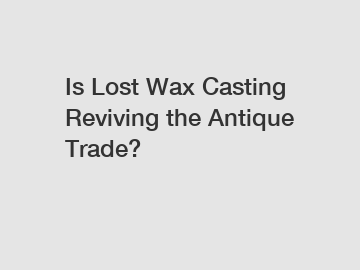Is Lost Wax Casting Reviving the Antique Trade?
Is Lost Wax Casting Reviving the Antique Trade?
In recent years, the antique trade has seen a significant resurgence, and one technique in particular has played a crucial role in its revival: lost wax casting. This ancient method of creating intricate and detailed metal objects has captured the attention of both collectors and artists, who appreciate its unique qualities and undeniable charm. But what exactly is lost wax casting, and why has it become such a driving force behind the resurgence of the antique trade?
Lost wax casting, also known as investment casting, dates back thousands of years and has been used to create a variety of objects, from jewelry to sculptures. The process begins with the creation of a wax model, which is then coated with a ceramic material to create a mold. Once the mold has been heated, the wax melts away, leaving a cavity in the shape of the desired object. Molten metal is then poured into the mold, filling the space and taking on the intricate details of the original wax model. Finally, the ceramic material is broken away, revealing the finished metal object.

One of the reasons lost wax casting has gained such popularity is its ability to capture the fine details of an object. The wax model allows for intricate designs and textures that can be difficult, if not impossible, to achieve through other casting techniques. This level of detail has been particularly appealing to collectors and enthusiasts who value the craftsmanship and artistry of the antique trade.
Furthermore, lost wax casting offers artists and craftsmen a versatile method of creating unique and personalized objects. With this technique, artists can easily replicate historical pieces or create original designs that evoke the spirit of antiquity. This ability to create custom-made pieces has propelled lost wax casting into the forefront of the antique trade, as collectors are eager to own one-of-a-kind works that pay homage to the past.
Another significant factor contributing to the revival of the antique trade through lost wax casting is the market demand for authentic and high-quality objects. In an age of mass production and impersonal goods, individuals are increasingly drawn to items that have a sense of history and craftsmanship. Lost wax casting fulfills this desire, as it allows for the creation of objects that possess a timeless quality and evoke a sense of nostalgia.
Moreover, lost wax casting has opened up a world of possibilities for antique restorations. With this technique, damaged or incomplete objects can be carefully replicated and restored to their former glory. This aspect of lost wax casting has been particularly beneficial for the antique trade, as it allows for the preservation and conservation of valuable historical artifacts.
However, despite its undeniable contributions, lost wax casting is not without its challenges. The process itself can be labor-intensive and time-consuming, requiring skilled craftsmen and specialized equipment. Additionally, the cost of producing objects using lost wax casting can be higher compared to other casting methods. These factors might limit the accessibility of lost wax casting to a wider audience and could pose a challenge to its continued growth within the antique trade.
In conclusion, lost wax casting has indeed played a significant role in reviving the antique trade. Its ability to capture intricate details, enable the creation of personalized and unique objects, and fulfill the market demand for authenticity has made it a driving force in this industry. Additionally, lost wax casting has opened up new avenues for antique restorations, ensuring the preservation of valuable historical artifacts. While it does face challenges, the future looks promising for lost wax casting, as it continues to captivate collectors and artists alike and breathe new life into the world of antiques.
For more information, please visit alloy steel lost wax casting, Machinery Parts Lost Wax Casting exporter, Lost wax casting for robotic components.

Comments
0